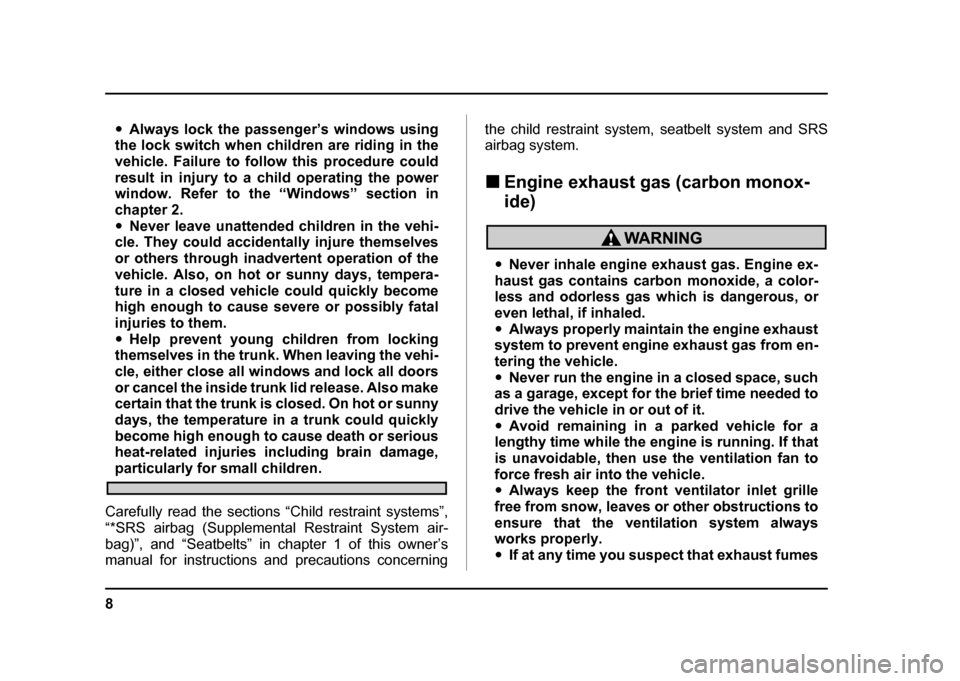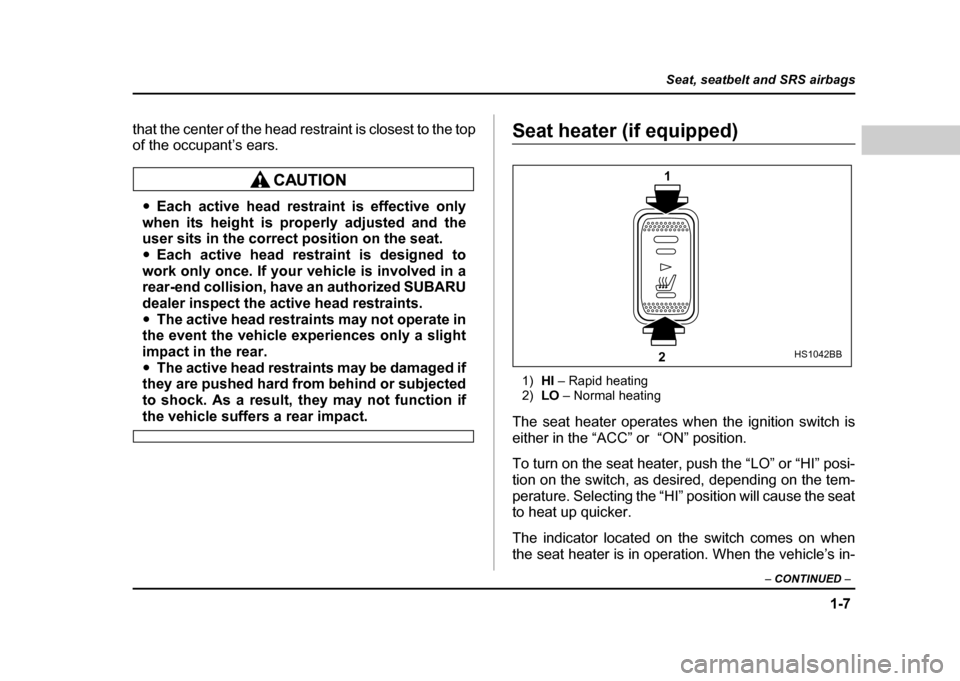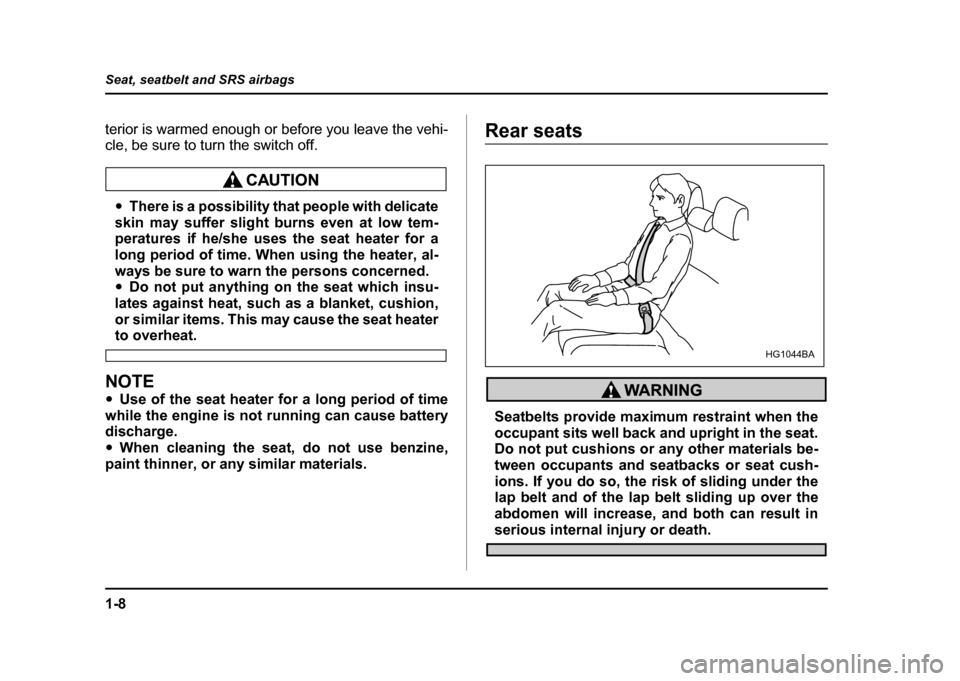Page 5 of 491

2
How to use this owner’s manual !Using your Owner’s manual
Before you operate your vehicle, carefully read this
manual. To protect yourself and extend the service life
of your vehicle, follow the instructions in this manual.
Failure to observe these instructions may result in se-
rious injury and damage to your vehicle.
This manual is composed of fourteen chapters. Each
chapter begins with a brief table of contents, so you
can usually tell at a glance if that chapter contains the
information you want.
Chapter 1: Seat, seatbelt and SRS airbags
This chapter informs you how to use the seat and seat-
belt and contains precautions for the SRS airbags.
Chapter 2: Keys and doors
This chapter informs you how to operate the keys,
locks and windows.
Chapter 3: Instruments and controls
This chapter informs you about the operation of instru-
ment panel indicators and how to use the instruments
and other switches.
Chapter 4: Climate Control
This chapter informs you how to operate the climate
control.
Chapter 5: Audio This chapter informs you how to operate your audio system.
Chapter 6: Interior equipment
This chapter informs you how to operate interior
equipment.
Chapter 7: Starting and operating
This chapter informs you how to start and operate your SUBARU.
Chapter 8: Driving tips
This chapter informs you how to drive your SUBARU
in various conditions and explains some safety tips on
driving.
Chapter 9: In case of emergency
This chapter informs you what to do if you have a prob-
lem while driving, such as a flat tire or engine over-
heating.
Chapter 10: Appearance care
This chapter informs you how to keep your SUBARU
looking good.
Chapter 11: Maintenance and service
This chapter informs you when you need to take your
SUBARU to the dealer for scheduled maintenance
and informs you how to keep your SUBARU running
properly.
Chapter 12: Specifications
This chapter informs you about dimension and capac-
ities of your SUBARU.
Page 11 of 491

8
"Always lock the passenger’s windows using
the lock switch when children are riding in the
vehicle. Failure to follow this procedure could
result in injury to a child operating the power
window. Refer to the “Windows” section in
chapter 2." Never leave unattended children in the vehi-
cle. They could accidentally injure themselves
or others through inadvertent operation of the
vehicle. Also, on hot or sunny days, tempera-
ture in a closed vehicle could quickly become
high enough to cause severe or possibly fatal
injuries to them." Help prevent young children from locking
themselves in the trunk. When leaving the vehi-
cle, either close all windows and lock all doors
or cancel the inside trunk lid release. Also make
certain that the trunk is closed. On hot or sunny
days, the temperature in a trunk could quickly
become high enough to cause death or serious
heat-related injuries including brain damage,
particularly for small children.
Carefully read the sections “Child restraint systems”,
“*SRS airbag (Supplemental Restraint System air-
bag)”, and “Seatbelts” in chapter 1 of this owner’s
manual for instructions and precautions concerning the child restraint system, seatbelt system and SRS airbag system. !
Engine exhaust gas (carbon monox- ide)
"Never inhale engine exhaust gas. Engine ex-
haust gas contains carbon monoxide, a color-
less and odorless gas which is dangerous, or
even lethal, if inhaled." Always properly maintain the engine exhaust
system to prevent engine exhaust gas from en-
tering the vehicle." Never run the engine in a closed space, such
as a garage, except for the brief time needed to
drive the vehicle in or out of it." Avoid remaining in a parked vehicle for a
lengthy time while the engine is running. If that
is unavoidable, then use the ventilation fan to
force fresh air into the vehicle. " Always keep the front ventilator inlet grille
free from snow, leaves or other obstructions to
ensure that the ventilation system always
works properly. " If at any time you suspect that exhaust fumes
Page 17 of 491
14
Illustrated index !Exterior
10
12 11 8 7 965
4
3
12UGF054BB
1) Engine hood (page 11-5)
2) Headlight switch (page 3-29)
3) Replacing bulbs (page 11-64)
4) Wiper switch (page 3-37)
5) Moonroof (page 2-31)
6) Door locks (page 2-3)
7) Tire pressure (page 11-45)
8) Flat tires (page 9-5)
9) Tire chains (page 8-16)
10) Front fog light switch (page 3-
35)
11) Tie-down hooks (page 9-17)
12) Towing hooks (page 9-17)
Page 18 of 491
15
–
CONTINUED –
12
34 4 623
4
45 17
UGF502BB
1) Rear window defogger switch
(page 3-40)
2) Fuel filler lid and cap (page 7-4)
3) Child safety locks (page 2-21)
4) Tie-down/Towing hook (page 9- 18)
5) Trunk lid (page 2-25)
6) Rear gate (page 2-29)
7) Roof rail (page 8-21)
Page 21 of 491
18
!
Instrument panel
12345 6
7
8
9
11
12
13
14
15
16 10
UGF056BB
1) Door locks (page 2-3)
2) Light control lever (page 3-29)
3) Combination meter (page 3-15)
4) Wiper control lever (page 3-35)
5) Hazard warning flasher switch
(page 3-6)
6) Audio (page 5-1)
7) Gear shift lever (MT) (page 7- 15)/Selector lever (AT) (page 7-
21)
8) Outside mirror switch (page 3-
48)
9) Climate control (page 4-1)
10) Cruise control (page 7-37)
11) Horn (page 3-50)
12) SRS airbag (page 1-52)
13) Tilt steering (page 3-49)
14) Fuse box (page 11-60)
15) Hood lock release (page 11-5)
16) Power window (page 2-22)
Page 22 of 491
19
–
CONTINUED –
!Light control and wiper control levers/switches
2
3
4
5
6
7
8
9
10
11
12 1
HSF025BB
1) Parking light switch (page 3-34)
2) Windshield wiper (page 3-37)
3) Mist (page 3-38)
4) Windshield washer (page 3-38)
5) Rear window wiper and washer
switch (page 3-39)
6) Wiper control lever (page 3-37)
7) Illumination brightness control (page 3-32)
8) Light control lever (page 3-29)
9) Headlight ON/OFF (page 3-29)
10) Headlight flasher High/Low beam change (page 3-29)
11) Turn signal (for lane change)
(page 3-31)
12) Turn signal (page 3-31)
Page 34 of 491

1-7
Seat, seatbelt and SRS airbags
– CONTINUED –
that the center of the head restraint is closest to the top
of the occupant’s ears.
"Each active head restraint is effective only
when its height is properly adjusted and the
user sits in the correct position on the seat. " Each active head restraint is designed to
work only once. If your vehicle is involved in a
rear-end collision, have an authorized SUBARU
dealer inspect the active head restraints." The active head restraints may not operate in
the event the vehicle experiences only a slight
impact in the rear." The active head restraints may be damaged if
they are pushed hard from behind or subjected
to shock. As a result, they may not function if
the vehicle suffers a rear impact.
Seat heater (if equipped)
1) HI – Rapid heating
2) LO – Normal heating
The seat heater operates when the ignition switch is
either in the “ACC” or “ON” position.
To turn on the seat heater, push the “LO” or “HI” posi-
tion on the switch, as desired, depending on the tem-
perature. Selecting the “HI” position will cause the seat
to heat up quicker.
The indicator located on the switch comes on when
the seat heater is in operation. When the vehicle’s in-
1
2
HS1042BB
Page 35 of 491

1-8
Seat, seatbelt and SRS airbags
terior is warmed enough or before you leave the vehi-
cle, be sure to turn the switch off.
"
There is a possibility that people with delicate
skin may suffer slight burns even at low tem-
peratures if he/she uses the seat heater for a
long period of time. When using the heater, al-
ways be sure to warn the persons concerned. " Do not put anything on the seat which insu-
lates against heat, such as a blanket, cushion,
or similar items. This may cause the seat heater
to overheat.
NOTE " Use of the seat heater for a long period of time
while the engine is not running can cause battery
discharge. " When cleaning the seat, do not use benzine,
paint thinner, or any similar materials.
Rear seats
Seatbelts provide maximum restraint when the
occupant sits well back and upright in the seat.
Do not put cushions or any other materials be-
tween occupants and seatbacks or seat cush-
ions. If you do so, the risk of sliding under the
lap belt and of the lap belt sliding up over the
abdomen will increase, and both can result in
serious internal injury or death.
HG1044BA